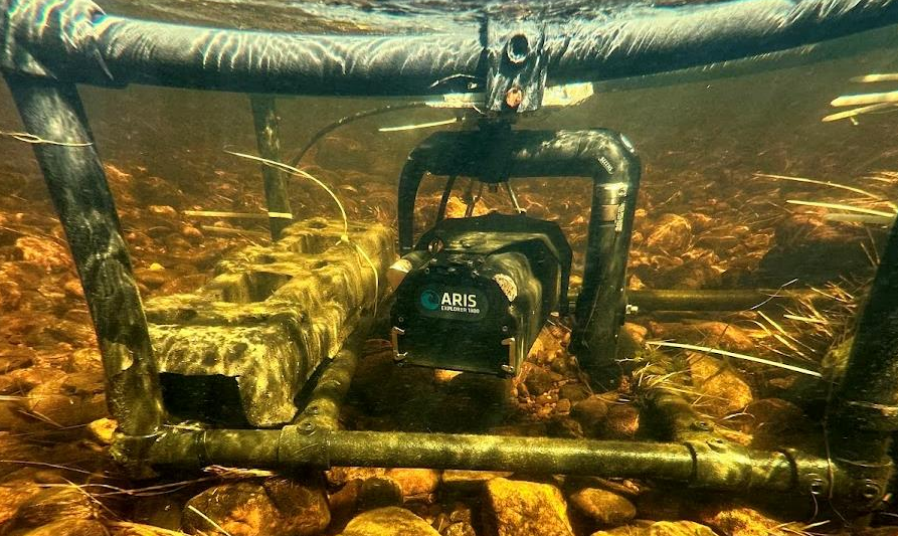Sonar imaging systems transforming salmon counts and supporting restoration efforts
Project Laxford and Project Deveron, the only two river systems in Scotland producing sonar imaging counts of returning adult salmon, release their second year of information.
Project Laxford and Project Deveron both employ state-of-the-art ARIS (Adaptive Resolution Imaging Sonar) fish counters. The information they record, combined with data modelling techniques, enables accurate counts of their entire adult salmon runs to be produced. This image shows a group of returning Laxford salmon as seen on an ARIS camera.
Project Laxford and Project Deveron are two catchment-scale wild salmon restoration projects combining ecosystem recovery with state-of-the-art monitoring of their wild salmon populations and wider biodiversity. They comprise the Atlantic Salmon Trust’s Core Rivers programme of partnership projects, where restoration solutions are put into action and their effects monitored over the long term. Their aim is to evidence successful wild salmon restoration techniques and therefore support wider conservation efforts regionally, nationally and internationally. Project Laxford is a partnership with Grosvenor’s Reay Forest Estate in Northwest Sutherland, and Project Deveron is a partnership with the Deveron, Bogie & Isla Rivers Charitable Trust in Aberdeenshire.
In addition to extensive programmes of salmon tagging and tracking in both river systems, as well as wider ecological surveying, both rivers are currently operating highly advanced ARIS (Adaptive Resolution Imaging Sonar) fish counters to accurately record the total number of adult salmon returning each year to spawn. These are the only two such systems currently operating in Scotland. This technology marks a considerable advance in our collective understanding of returning salmon numbers, which historically have been determined through less accurate rod catch reports from anglers. The two sonar counters on these rivers have been funded by the Scottish Government’s Marine Directorate, are operated and maintained locally by project teams, before the data is then modelled by the Marine Directorate to produce an overall returning adult salmon count.
A group of returning adult salmon identified on an ARIS camera.
2024 Counts
Laxford
2023: 1,120
2024: 1,376
In 2023, the median Laxford count was determined to be 1,120, with a count of 1,376 in 2024. This represents a 22.85% increase from 2023-2024.
Deveron
2023: 5,705
2024: 8,796
On the Deveron, the median count for 2023 was determined to be 5,705 with a count of 8,796 for 2024, representing a 54.18% increase between 2023 and 2024.
Of additional interest to readers may be the rod catch rate on the Deveron over these two years. Figures show that 766 salmon were caught by anglers on the river in 2023, representing a 13-14% rod catch rate. The rod catch for 2024 was reported as 1,711, representing a rod catch rate of 19%. Thus, while the run size increased by 54% in 2024, angler catches increased by 123%. This insight reaffirms the importance of collecting accurate counts of returning adult salmon to gain a true picture of population changes from year to year.
Over time, as more years of returning adult salmon counts are generated by ARIS sonar counts and this information is combined with smolt counts and marine survival rates, the Atlantic Salmon Trust and its partners hope to build a greater understanding of the impact and effectiveness of restoration and management actions in these two catchments.
Mark Bilsby, CEO of the Atlantic Salmon Trust said:
This is an excellent demonstration of the sort of cutting-edge technology currently being employed in the Core Rivers programme, the funding and operation of which is made possible through local and national public and private partnerships. We can look at historic trends to understand the decline in wild Atlantic salmon over past decades, but we hope that over time this new level of year-to-year accuracy will enable us to make a direct link between restoration efforts and recovering wild salmon populations in the future.
Supporting Scotland's Nationwide Salmon Population Assessments
The Laxford and Deveron counter data is being used to assess the conservation status of salmon within these rivers. It is also being used to develop new methods to support the Scottish Government's annual assessments of the health of wild salmon populations across the country. Each year, these assessments grade salmon rivers either 'Good', 'Moderate' or 'Poor' in relation to their likelihood of meeting their 'Conservation Limit' - the minimum number of eggs which need to be deposited by spawning adult salmon to enable the population to sustain itself.
Current river gradings can be accessed on the Scottish Government's website: Salmon fishing: final river gradings for the 2025 season - gov.scot.


